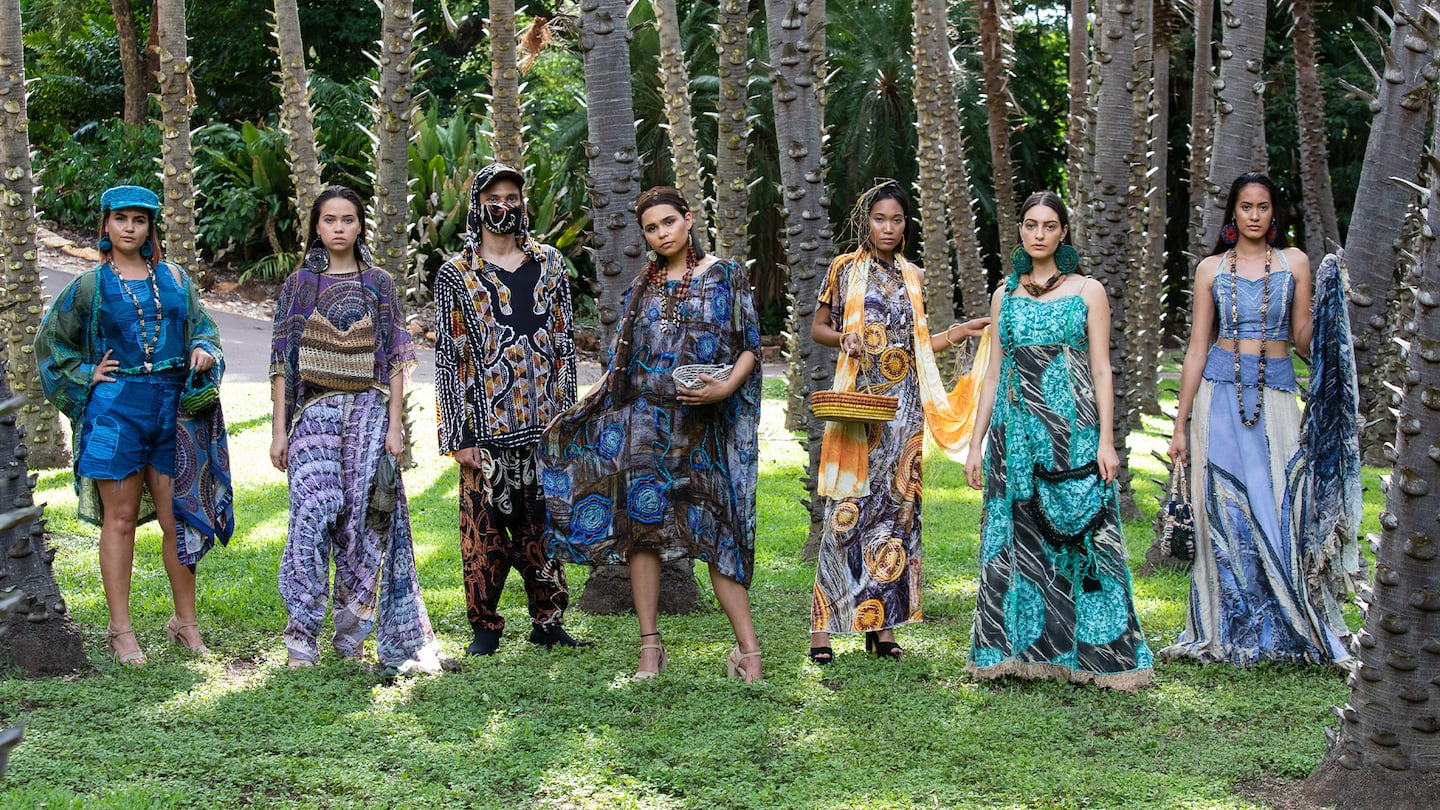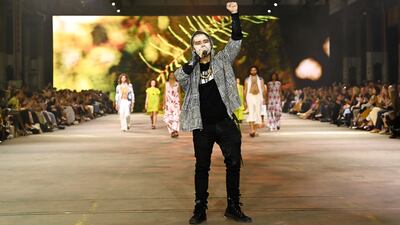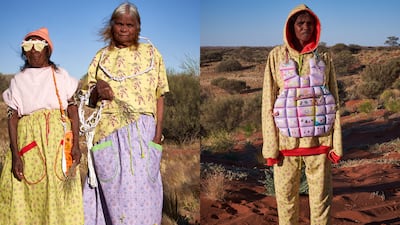
The Business of Fashion
Agenda-setting intelligence, analysis and advice for the global fashion community.

Agenda-setting intelligence, analysis and advice for the global fashion community.

“This is not a moment. This is a movement.” The banner at the First Nations Fashion and Design (FNFD) show during Australian Fashion Week said it all.
There were no fewer than five Indigenous fashion events throughout Australian Fashion Week (AFW) in May. After years of marginalisation and underrepresentation in the Australian fashion industry, the visibility of First Nations designers is on the rise, with Lillardia Briggs-Houston, Corina Muir, Lynelle Flinders and Jessica Johnson among those leading the charge.
First Nations Australians are Indigenous peoples from Aboriginal and Torres Strait Islander communities, who have inhabited the country for millennia before colonisation by Europeans.
The FNFD show, which featured First Nations Australians on the catwalk, making the clothes, and behind the scenes in a spectacle that put fashion in the broader cultural context of dance, art and live musical performance, moved seasoned industry professionals to tears and brought the audience to a standing ovation at its climax.
ADVERTISEMENT

“I’m so proud to be here with some truth-telling about our stories and what we can bring to the fashion industry,” said designer Grace Lillian Lee after the show. “This is a push to celebrate who we are and create spaces so we can heal as a nation and understand our history.”
Events such as these are also seen by some as a foundation upon which to bolster business opportunities for Indigenous peoples in the sector.
Accelerating economic empowerment and business development
Lee is the founder of First Nations Fashion and Design, a not-for-profit Indigenous corporation aimed at supporting the growth of the Indigenous fashion industry through self-determination and economic empowerment.
Lee, who is a descendant of the Miriam Mer people of the Eastern Islands of the Torres Strait, founded FNFD in 2020 with its chief executive Teagan Cowlishaw, who is a descendant of Nyikina people and has paternal kinship with Bardi and Nyul Nyul people, joining shortly after. The pair have been running FNFD on a voluntary basis, close to full-time, ever since. The project, they say, has been years in the making.
“First Nations fashion and design has the power to create change in social, economic and political landscapes,” says Cowlishaw. “It has the power to educate consumers about the social issues we face and to offer them a way to support First Nations businesses and brands,” says Cowlishaw.
The brands that took part in the FNFD show received support for their businesses beyond the initial runway exposure, including complimentary membership of the Australian Fashion Council, the country’s highest industry body, collective editorial coverage worth an estimated AUD 52 million ($38 million), and a post-show package including lookbook imagery, a line sheet for sales and video imagery for their websites and social media channels.
They also gained direct access to buyers on-site throughout the week and an online portal through digital sales platform Ordre, which set up profiles for each brand giving them access to a database of over 10,000 international buyers and retailers.
ADVERTISEMENT
“There has been a lot of traction and it’s really amazing to be in this position,” says Briggs-Houston, a Wiradjuri Yorta Yorta Gangulu designer who creates resortwear under her Ngarru Miimi brand. “The growth is great and it’s given us a greater platform and voice, which I’m really grateful for.”
Future plans for FNFD include a dedicated First Nations Fashion Festival and stand-alone designer shows during Australian Fashion Week, which this year also featured a runway show curated by Indigenous Fashion Projects (IFP), an Aboriginal and Torres Strait Islander-owned organisation with explicitly commercial aims. Founded by the Darwin Aboriginal Art Fair Foundation, it works to support Indigenous designers with a range of development programmes, mentoring opportunities and promotional events, including the National Indigenous Fashion Awards established in 2020.
“We focus on building capability, broadening connections and supporting collaborations, all with the overriding goal of the promotion and protection of culture,” says IFP manager Dave Giles-Kaye.
This year IFP produced a fashion week show in partnership with Australian department store David Jones, which paired six established Indigenous designers with the founders of six brands in order to help them grow their businesses. The initiative was part of its Pathways Programme, an ongoing support of Indigenous designers, and included workshops and mentoring as well as the runway show.
Natalie Cunningham, the owner and director of Native Swimwear Australia who showed a range of swim, jewellery and activewear — all made with recycled marine plastics — likened the IFP programme to “being given the keys” to expand into wholesaling. “In 15 years I’ve never had an opportunity like this,” she said. Cunningham, who in 2015 became the first Australian Indigenous designer known to show at New York Fashion Week, is also a finalist in the Australian Indigenous Fashion Awards, which will take place in Darwin on August 3 as part of the Darwin Aboriginal Art Fair.
Recognising excellence in design and innovation across six categories, the awards are sponsored by the Northern Territory Government and a host of industry supporters including Australian high street brand Country Road. This year 31 nominations were received for the awards, in which designers will compete across categories including fashion and textile design, social contribution, community collaboration and wearable art, followed the next day by the Country to Couture runway show in Darwin on August 4.

“We are seeing more First Nations fashion businesses seeking commercial success now than ever,” says Country to Couture creative director Perina Drummond, who is also the founder of Jira Models, a modelling agency for Aboriginal and Torres Strait Islander people. “But inequality still exists in our society today, and we have a long way to go in dismantling over 200 years of systemic injustice and seeking equality for First Nations people.”
New momentum for long-fought equality campaigns
ADVERTISEMENT
Life expectancy, employment and literacy rates all remain lower for Indigenous Australians than the overall population, according to the “Closing The Gap” report released by the Australian government in 2020. The report tracked targets set in 2008 aimed at reducing inequality.
Targets are falling short in child mortality, school attendance, literacy and numeracy, employment and life expectancy, according to the report, which found Aboriginal Australians and Torres Strait Islanders, who together comprise 3 percent of Australia’s population, continue to experience high levels of disadvantage in society.
“Inequality and the marginalisation of First Nations people is still a massive problem,” says Briggs-Houston. “I can see baby steps being taken and more support from wider Australia, but we still have a very long way to go.”
Indigenous Affairs Minister Ken Wyatt, the first ever Aboriginal person to hold the position, said governments needed to draw on the insights, knowledge and lived experiences of Indigenous Australians to deliver on the report. “Indigenous Australians are the key agents of change,” he wrote in The Sydney Morning Herald newspaper.
The long history of campaigns by Indigenous Australians and their allies to redress marginalisation and oppression has been accelerated by recent international movements like Black Lives Matter, giving a centuries-old movement an even greater sense of urgency.
“Black Lives Matter certainly shone the spotlight on many Indigenous businesses,” says Denni Francisco, a Wirdadjuri woman whose latest collection features prints translated from artwork by Lindsay Malay from the Warmun Art Centre in Ngali. “There hasn’t been the opportunity in the past to show the creativity that exists within our culture and how that is being translated into fashion, and there is a lot of activity on social media now that brings greater awareness to all we do and achieve in this space.”
Nathan McGuire, a Whadjuk Noongar model who serves as FNFD ambassador and mentor, helped put the global context into perspective when he spoke on an Indigenous fashion panel during fashion week. “When we see what’s happening around the world it rings a bell to what is happening in Australia,” he explained. But “our 160,000 years-plus history here is not a DM or a 140-character tweet. We need you to be really inquisitive about our First Nations people here in Australia, to ask us questions and learn about our culture. That will help us open doors.”
Indii Swimwear designer Nancy Pattison said Australia’s Support Blak Business movement and Instagram accounts such as Trading Blak are leading to unprecedented conversations and commercial outcomes on social media. ‘Blak’ is a word reclaimed and adapted by some Indigenous Australians to counter narratives of Black people in the Australian historical context in a way that also acknowledges their distinct lived experience from other interpretations of Blackness.

“I sell my designs online and market through social media and these digital platforms are paving the way for greater exposure for Indigenous labels,” says Pattison, a Saltwater Dunghutti woman who started her label on country in Northern New South Wales in 2015.
‘On country’ is a phrase used by Indigenous Australians to express the connection of the land they live on to their identity over the course of generations.
The rise of Indigenous brands is also being driven in part by a broader shift to embrace sustainability in fashion.
“Many of our designers are led by an inherent consciousness of caring for the land and community, and a lot of the big brands and consumers are now also seeing sustainability and environmental consciousness as the future of fashion,” says National Gallery of Victoria Indigenous curator Shonae Hobson.
Hobson curated the “Piinpi: Contemporary Indigenous Fashion” exhibition, which opened at the Bendigo Art Gallery in November before the Melbourne Fashion Festival hosted the First Nations runway show Walking in Two Worlds. “There have been so many highlights for Indigenous designers this year,” she says. “It’s a pinnacle moment for them to get themselves seen and heard.”
Future challenges and meaningful commitments
While the outlook for Indigenous designers certainly seems brighter than it did just a few years earlier, a number of challenges remain beyond the economic disadvantages they experience in wider society. They include a lack of access to fashion training, underrepresentation in the industry and the ongoing issue of cultural appropriation.
With Australia’s major fashion schools located in the country’s largest cities, Indigenous designers located in rural or distant communities are often unable to undertake formal degrees unless they study remotely.
“To further my training in fashion I drive five hours, sometimes daily, from my rural town,” says Briggs-Houston. “This isn’t an option for many people, and it comes at a big sacrifice to my family and work.”
With many First Nations community members living on low incomes or below the poverty line, the costs of undertaking a degree or running a label afterwards can be prohibitive.

“Materials and other elements of running a business are expensive, and I can’t grow or expand if I don’t have the income,” says Briggs-Houston. “A one-year growth plan turns into a four-year plan because that’s the amount of time it takes to save the money required on a low income. There is currently so much demand for First Nations fashion but very little support for designers and businesses, so it’s a catch-22.”
The spectre of cultural appropriation, including “Indigenous-inspired” textiles and cheap souvenirs, is also never far from designers’ minds. “Think about the thousands of boomerangs or tea towels that are made and sold without any artist or community permissions,” says Giles-Kaye.
Fashion is not immune to the practice either when non-Indigenous stakeholders are the only financial beneficiary in the value chain. Some commentators have called for a certification system, similar to “Australian made” labelling, while Indigenous business collectives such as Trading Blak call for greater transparency and accountability for people trading within the First Nations space.
“We are still seeing cultural appropriation, ‘Black cladding’ and Black-appearing businesses happening within the art, fashion, and business space,” says Briggs-Houston. “These practices are so harmful to us and an insult to long, rich and thriving First Nations cultures and people.”
Dialogue with the country’s official industry bodies about these and other issues is ongoing. The Australian Fashion Council says it is meeting with Indigenous leaders and designers to learn how it can further support the progress of First Nations fashion through business development and upskilling programmes.
“What the FNFD show proved is that Indigenous designers are able to communicate in extraordinary ways, more powerful than anything else I’ve seen on a runway,” says editorial director of the Australian editions of Vogue, Vogue Living and GQ, Edwina McCann. “They have taken the power back, and quite rightly, to express a First Nations vision as communicated by First Nations people.
She said many Indigenous design businesses were eschewing the traditional wholesale model in favour of direct-to-consumer sales online, as part of an increasing global trend and for their own reasons.
“They don’t wish to be dictated to by the norms and constraints of the traditional industry and we have had great discussions about how we can best support them to drive real business outcomes — their way,” says McCann.

Natalie Xenita, vice president and managing director of IMG Fashion Asia-Pacific, which runs Australian Fashion Week (AFW), agreed that assisting Indigenous designers to build long term, sustainable fashion businesses was a key responsibility for organisations like hers in the wake of media and industry attention during fashion week.
“It’s imperative that we utilise AFW’s platform to bring forth conversations of representation and inclusion to the forefront, [so] we are investing long-term in Indigenous talent through our events and properties,” Xenita says.
IMG’s Australian Fashion Laureate award, the peak award for fashion designers in the country, will now be expanded to recognise excellence in Indigenous design, and a ‘welcome to country’ ceremony will be a permanent event on the AFW schedule. These are ceremonies performed at events, intending to highlight the cultural significance of the surrounding area to Indigenous peoples who are recognised as traditional owners of the land where the event is taking place.
“Off the back of what has been a milestone year for First Nations fashion designers, IMG is committed to recognising excellence in this fledgling area of the Australian fashion industry,” Xenita says.
If the Australian fashion industry is to truly embrace Indigenous design and empower Indigenous designers in business, more meaningful commitments and accountability frameworks are needed across the sector. One urgent priority is for the industry to foster greater representation of Indigenous peoples at a decision-making level.
“The biggest issue for the future of the industry is having voices on the board of directors and working at Australian Fashion Week,” says Hobson. “It’s about taking that next step to give Indigenous people positions and power.”
The adoption of reconciliation action plans (strategic documents that provide an organisation with a framework to support Australia’s national reconciliation movement) and a commitment to Indigenous internships and permanent employment opportunities within fashion businesses are also necessary to bring about real and lasting change.
“There needs to be a proactive approach by all brands to grow the inclusion of First Nations representation in the fashion industry,” says Francisco. “Much more needs to happen but there is definitely a groundswell underway, which is cause for optimism about the future.”
Related Articles:
Australia Invests Big in Its Fashion Industry
This week’s round-up of global markets fashion business news also features the China Duty Free Group, Uniqlo’s Japanese owner and a pan-African e-commerce platform in Côte d’Ivoire.
Affluent members of the Indian diaspora are underserved by fashion retailers, but dedicated e-commerce sites are not a silver bullet for Indian designers aiming to reach them.
This week’s round-up of global markets fashion business news also features Brazil’s JHSF, the Abu Dhabi Investment Authority and the impact of Taiwan’s earthquake on textile supply chains.
This week’s round-up of global markets fashion business news also features Dubai’s Majid Al Futtaim, a Polish fashion giant‘s Russia controversy and the bombing of a Malaysian retailer over blasphemous socks.